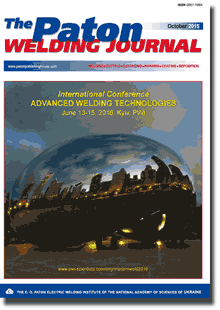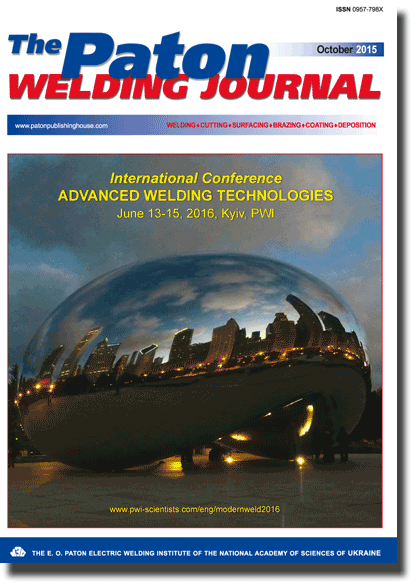| 2015 №10 (05) |
DOI of Article 10.15407/tpwj2015.10.06 |
2015 №10 (07) |

The Paton Welding Journal, 2015, #10, 36-42 pages
Modern composite materials for switching and welding equipment. information 1. powdered composite materials
E.V. Khomenko, N.I. Grechanyuk And V.Z. Zatovsky
I.M. Frantsevich Institute of Problems of Materials Science, NASU 3 Krzhizhanovsky Str., 03142, Kiev, Ukraine. E-mail: homhelen@mail.ru
Abstract
The paper presents modern developments in the field of powdered composite materials of pseudoalloy type based on Cu (Ag) and refractory metals W (Mo, Cr), used as electric contact materials and welding electrodes. Main requirements made of materials of arcing contacts and resistance welding electrodes are briefly described. Main data from world manufacturers on compositions and regulated characteristics of this material type are given, and main process schematics of their manufacturing are listed. Certain technological difficulties of producing nanodispersed composites are pointed out that slow down their production on an industrial scale. It is noted that application of mechanical alloying method during high-energy milling of powders allows producing copper, dispersion-strengthened by refractory oxides and carbides (Al2O3, TiO2, Cr2O3, SiO2, etc.) with recrystallization temperature close to that of copper melting and higher level of electric conductivity, strength and oxidation resistance, compared to chromium and chromium-zirconium bronzes. 41 Ref., 5 Tables, 4 Figures.
Keywords: copper-based powdered composite materials, switching and welding equipment
Received: 27.04.15
Published: 01.12.15
References
- (1978) Composite materials. Vol.3: Application of composite materials in engineering. Moscow: Mashinostroenie.
- Tuchinsky, L.I. (1986) Composite materials produced by impregnation method. Moscow: Metallurgiya.
- (1990) Composite materials: Refer. Book. Ed. by V.V. Vasiliev, Yu.M. Tarnopolsky. Moscow: Mashinostroenie.
- Gnesin, G.G., Dubok, V.A., Braterskaya, G.N. et al. (1981) Sintered materials for electrical engineering and electronics: Refer. Book. Moscow: Metallurgiya.
- Evdokunin, G.A., Tiler, G. (2000) Modern vacuum switching equipment of medium voltage. St.-Petersburg: M.P. Sizov Publ.
- Vacuum switching equipment and components for medium voltage networks. Siemens. http://w3.siemens.com/powerdistribution/global/SiteCollectionDocuments/en/mv/indoor-devices/vacuum-switchi ng-technology-and-components_ru.pdf
- Slade, P.G. (1998) Electric contacts for power interruption: A review. In: Proc. of 19th Int. Conf. on Electric Contact Phenom. (Nuremberg, Germany, 1998), 239-245.
- Contact materials for electrical engineering. Electrical contacts Wiki. http://www.electrical-contacts-wiki.com/index.php/Contact_Materials_for_Electri cal_Engineering
- Bregel, T., Kraussvogt, W., Michal, R. et. al (1991) On the application of W/Cu materials in the fields of power engineering and plasma technology. IEEE Transact. on Copmonents Hybrids and Manufact. Technology, 14, 8-13.
- Namitokov, K.K. (1978) Electroerosion phenomena. Moscow: Energiya.
- Minakova, R.V., Khomenko, E.V., Kopylova, G.E. et al. (2012) Secondary structure in working layer of electrical contacts from composite materials and their functional properties. In: Electrical contacts and electrodes, 38-47. Kiev: IPMS.
- Livshits, B.G. (1980) Physical properties of metals and alloys. Moscow: Metallurgiya.
- Fedorchenko, I.M., Frantsevich, I.N., Radomyselsky, I.D. (1985) Powder technology: Materials, technology, properties, fields of application: Refer. Book. Kiev: Naukova Dumka.
- Zakharov, A.M. (1990) Constitutional diagrams of binary and ternary systems. Moscow: Metallurgiya.
- Plansee Group. Fields of competence. Technologies. http://www.plansee.com/en/About-us-Expertise-T echnology-118.htm
- Hula, R.Ch., Edmaier, Ch. (2000) Silver coated tungsten carbide powders for composite electrical contact application. Powder Metallurgy Progress, 9(1), 34-41; http://www.imr.saske.sk/pmp/issue/1-2009/PMP_Vol09_No1_p034-041.pdf
- Slade, P. (2007) The vacuum interrupter. Theory, design and application. London: Taylor and Francis Books.
- Najdich, Yu.V. (1972) Contact phenomena in metal melts. Kiev: Naukova Dumka.
- Avraamov, Yu.S., Shlyapin, A.D. (1999) Novel composite materials based on immiscible components: Producing, structure and properties. Moscow: MGU.
- Smaga, N.N., Yudin, B.A., Markov, E.V. (1965) Method of producing and test results of fine-dispersed metal-ceramic compositions for contacts of electric apparatuses. In: Electrical metal-ceramic products. Moscow: VNIIEM.
- Kornienko, V.P., Yudin, B.A., Kolesnikov, V.N. (1977) Fine-grained composite contacts for low-voltage equipment. In: Electrical contacts and electrodes, 70-79. Kiev: Naukova Dumka.
- Rieder, W.F., Schussek, M., Glatzle, W. et al. (1989) The influence of composition and Cr-particle size of Cu/Cr contacts on chopping current, contact resistance and breakdown voltage in vacuum interrupters. IEEE Transact. on Components Hybrids and Manufact. Techology, 12(2), 273-283. https://doi.org/10.1109/33.31434
- Laptiev, A., Tolochyn, O., Khomenko, O. et al. (2014) Solid state impact sintering in vacuum of composites based on copper and silver. In: Proc. of 27th Conf. on Electrical Contacts (Dresden, Germany, June 22-26, 2014), 457-462.
- Tungsten and molybden based materials. Powered by Doduco. http://www.electrical-contacts-wiki.com/ index.php/Tungsten_and_Molybdenum_Based_Mate rials
- Plansee Group. http://www.plansee.com/ru/Products-Electrical-contacts-Tungsten-copper-WCu-58.htm
- Plansee Group. http://www.plansee.com/ru/Products-Electrical-contacts-Copper-chromium-CuCr-59.htm
- Najdich, Yu.V., Lavrinenko, I.A., Evdokimov, V.A. (1974) Study of compaction process in liquid-phase sintering under pressure in tungsten-copper system. Poroshk. Metallurgiya, 1, 34-39.
- Panichkina, V.V., Sirotyuk, M.M., Skorokhod, V.V. (1982) Liquid-phase sintering of high-dispersed tungsten-copper mixtures. Ibid., 6, 27-31.
- Grill, R., Klausler, P., Mueller, E.-H. et al. (2005) WC/Ag contact materials with improved homogeneity. In: Proc. of 16th Int. Plansee Seminar (Reutte, Austria), 200-211.
- Amirjan, M., Zangeneh-Madar, K., Parvin, N. (2009) Evaluation of microstructure and contiguity of W/Cu composites prepared by coated tungsten powders. Refractory Metals and Hard Materials, 27, 729-733. https://doi.org/10.1016/j.ijrmhm.2008.12.008
- Dorfman, L.P., Scheithauer, M.J., Paliwal, M. et al. Alloy for electrical contacts and electrodes and method of making. Pat. US 6375708 B1. Publ. 23.04.2002.
- Moon-Hee Hong, Ja-Ho Choi, Seoung Lee et al. W-Cu alloy having homogeneous micro-structure and manufacturing method thereof. Pat. US 7172725 B2. Publ. 6.02.2007.
- Wingert, P.S. (1993) The effect of Ni on the switching performance of AgW based on contacts. In: Proc. of 39th IEEE Holm Conf., 111-115. https://doi.org/10.1109/HOLM.1993.489667
- Batrakov, A.V., Popov, S.A., Proskurovsky, D.I. (1996) Electrodynamic phenomena in exploding tungsten electrical contacts. In: Proc. of 42nd IEEE Holm Conf., 129-136.
- Gulyaev, A.I. (1985) Technology and equipment for resistance welding. Moscow: Mashinostroenie.
- (1986) Technology and equipment of resistance welding. Moscow: Mashinostroenie.
- Toshiba materials Co Ltd. Elkonite. http://www. toshiba-tmat.co.jp/eng/list/ta_elc.htm
- Contacts metals welding. Typical properties of Elkonite materials. http://www.tjsnow.com/supplies/ cmw/w49f.pdf
- Kos, M., Fercec, J., Bruncko, M. et al. (2014) Pressing of partially oxide-dispersion-strengthened copper using the ECAP process. Mater. and Technology, 48, Issue 3, 370-384.
- Discom-welding. Nanostructural materials and their products. http://discom-svarka.ru/dukm/
- Anoshin, V.A., Ilyushenko, V.M., Minakova, R.V. (2010) Heat-resistant materials based on copper. Method of producing. Properties. Applications. In: Transact. of IPMS, 212-218.
Suggested Citation
E.V. Khomenko, N.I. Grechanyuk And V.Z. Zatovsky (2015) Modern composite materials for switching and welding equipment. information 1. powdered composite materials. The Paton Welding J., 10, 36-42.The cost of subscription/purchase order journals or individual articles
| Journal/Currency | Annual Set | 1 issue printed |
1 issue |
one article |
| TPWJ/USD | 384 $ | 32 $ | 26 $ | 13 $ |
| TPWJ/EUR | 348 € | 29 € | 24 € | 12 € |
| TPWJ/UAH | 7200 UAH | 600 UAH | 600 UAH | 280 UAH |
| AS/UAH | 1800 UAH | 300 UAH | 300 UAH | 150 UAH |
| AS/USD | 192 $ | 32 $ | 26 $ | 13 $ |
| AS/EUR | 180 € | 30 € | 25 € | 12 € |
| SEM/UAH | 1200 UAH | 300 UAH | 300 UAH | 150 UAH |
| SEM/USD | 128 $ | 32 $ | 26 $ | 13 $ |
| SEM/EUR | 120 € | 30 € | 25 € | 12 € |
| TDNK/UAH | 1200 UAH | 300 UAH | 300 UAH | 150 UAH |
| TDNK/USD | 128 $ | 32 $ | 26 $ | 13 $ |
| TDNK/EUR | 120 € | 30 € | 25 € | 15 € |
AS = «Automatic Welding» - 6 issues per year;
TPWJ = «PATON WELDING JOURNAL» - 12 issues per year;
SEM = «Electrometallurgy Today» - 4 issues per year;
TDNK = «Technical Diagnostics and Non-Destructive Testing» - 4 issues per year.


